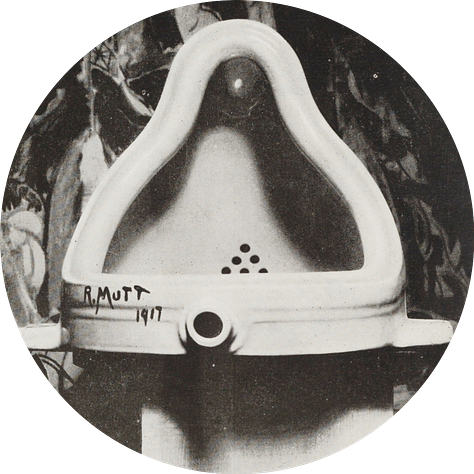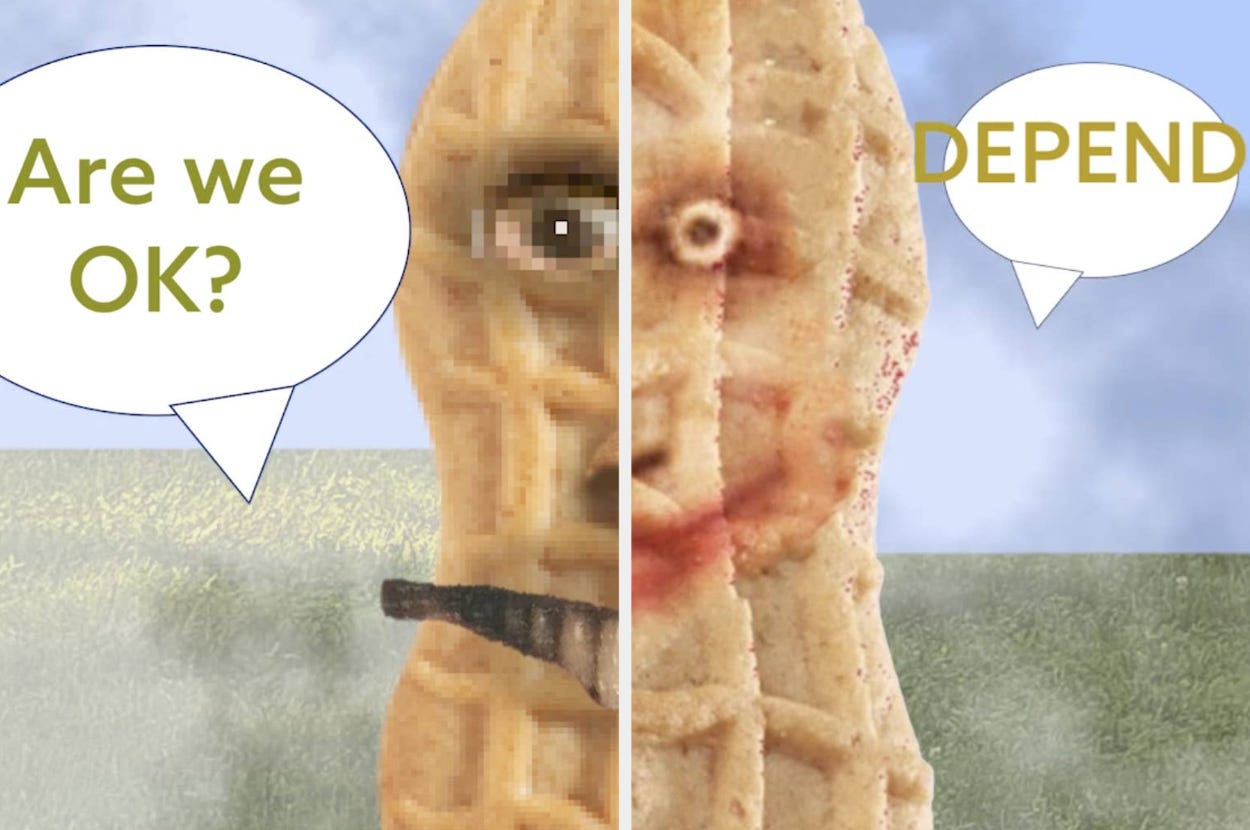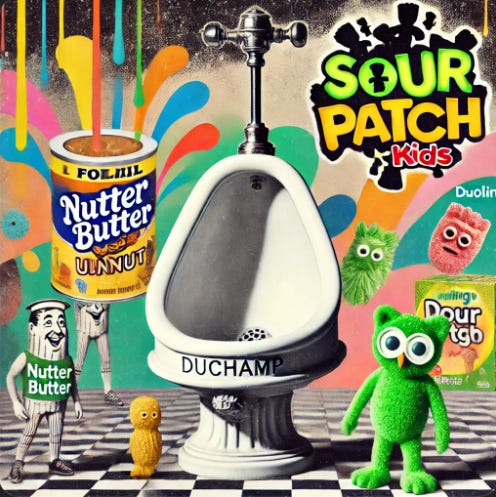Nutter Butter, Dadaism & The Age of Absurd Advertising
A Brief History of Nonsense: From the Dadaists to Duolingo
On a chilly spring evening in 1916, a Romanian poet named Tristan Tzara stood on a small stage in Zurich’s Cabaret Voltaire. In front of a baffled audience, he recited a poem composed entirely of nonsensical syllables. The words didn’t mean anything. That was the point. The audience jeered, some threw objects, others laughed. Tzara smiled.
Around the same time, in New York, Marcel Duchamp took a different (but equally shocking) approach. He submitted a porcelain urinal, turned on its side, to an art exhibition under the title Fountain. It wasn’t painted, sculpted, or altered in any way. It was just… a urinal.
And yet, it became one of the most famous artworks of the 20th century for asking the question: Who decides what counts as art? If meaning was meaningless, then why should art make sense?



Now, over a hundred years later, there’s a cookie doing something remarkably similar.
The Nutter Butter TikTok account is, at first glance, baffling. Videos of cookies arranged in haunted dollhouses. Grainy images of peanut butter smeared on miniature furniture and poultry. A mysterious doll named Aidan chasing a cookie through a surreal, fever-dream landscape. It’s not clear why these videos exist or what they’re trying to say. And yet, they’ve been viewed millions of times. People share them. Comment on them. Obsessively try to decode them.
What’s going on here? To understand, you have to start with The Dadaists.
The Dada Instinct
Dada (pronounced DAH-dah) wasn’t just an art movement. It was a reaction, a cultural reflex to a world that no longer made sense.
World War I had destroyed Europe’s faith in progress, reason, and structure. Then just as the war ended, the 1918 influenza pandemic ravaged the globe, killing millions and compounding the sense that life was meaningless and unpredictable. If the world was nonsensical, the Dadaists reasoned, then art should be too.
Something similar is happening today. Our world isn’t being torn apart by trench warfare, but it is being reshaped by disruptive forces compounded by information overload. Every day, we’re bombarded by thousands of headlines, posts, videos, and memes. The sheer volume is overwhelming. The truth feels impossible to discern. Like the Europeans of Tzara’s day, we live in a world that often feels absurd.
Enter Nutter Butter.
The Anti-Ad Revolution
For decades, advertising was about clarity. The goal was to tell a simple, persuasive story: This car will make you feel powerful. This cereal will make your kids happy. This shampoo will make your hair shiny. In the 1920s, Listerine got inventive, popularizing the word “halitosis” and transforming bad breath from an unfortunate reality into a diagnosable medical condition that only their mouthwash could fix.
The formula was simple: identify a problem, offer a solution, and sell the fix. But in the chaos of the internet age, clarity is no longer enough. On platforms like TikTok, where a million creators are competing for attention, the only way to stand out is to be incomprehensible.
This is why Nutter Butter’s absurdist approach works. By rejecting the conventions of advertising and refusing to sell anything at all, it forces viewers to stop scrolling and pay attention. It doesn’t matter if they understand the message. What matters is that they’re watching.
Like Duchamp’s Fountain, absurdist marketing takes an everyday object and strips it of its expected context. The joke isn’t just the product, it’s the disruption of expectation. Just as Duchamp exposed the absurdity of the art world, modern brands are exposing the absurdity of modern advertising, where the goal isn’t persuasion but attention.
This strategy isn’t unique to Nutter Butter. Brands like Sour Patch Kids and Crocs have also leaned into absurdist humor. But Nutter Butter has gone further, creating content that feels almost hostile to its own audience. And in doing so, it has become one of the most talked-about brands of the year.
And that tells us something interesting about where we are right now.
The Death of Duo
If there was any doubt that absurdist marketing is now a dominant force, Duolingo just settled the debate by killing its own mascot.
Duo, the green owl that has haunted the dreams of language learners for over a decade, was hit by a Tesla Cybertruck and launched into the heavens in a bizarre, week-long social media saga. Brands like Cap’n Crunch, A&W Root Beer, and Drumstick jumped in, each posting their own absurd reactions. The Cap’n tried to hide everywhere, wondering if brand mascots were safe anymore. The A&W bear solemnly poured one out in Duo’s honor. And Drumstick posted a hilarious animated video of its cone character, sitting in a convertible with a dog, watching in horror as Duo’s neon-green demise splattered across their windshield.
It’s all utterly ridiculous, which is exactly why it works. The campaign is the viral sensation of 2025 so far. Even the World Health Organization weighed in!
In the world of TikTok, the rules of traditional marketing have been turned upside down. If a company is trying to sell you something, it’s doing it wrong. Instead, brands now compete to out-weird each other, leaning into surreal humor to make people stop scrolling. The genius of Nutter Butter’s campaign was that it felt so unhinged it almost seemed like a mistake, but the unpredictability made it unforgettable. Duolingo has taken the same playbook and turned it into a soap-opera-style mystery, complete with a suspicious death, a grieving community, and the implied promise of a resurrection.
The takeaway? Absurdity isn’t just a trend in advertising; it’s becoming the dominant language of engagement. If a century ago Dadaism was a rebellion against the rational, modern world, today’s absurdist marketing is a response to an algorithm-driven attention economy that rewards chaos, unpredictability, and meme-worthy spectacle.
And the brands that embrace the madness are winning.
Will these surreal TikTok campaigns be remembered a century from now, the way we remember Dadaism? Probably not. But they’re tapping into something timeless: our need to make sense of a senseless world.
A century ago, Dadaism shattered the illusion that life was orderly and predictable. It revealed the absurdity lurking beneath polite society. Today, Nutter Butter (and the broader trend of anti-marketing) does something similar. It reflects the absurdity of the modern world back at us, not with an explanation, but with a wink. Sometimes, the only way to deal with chaos is to laugh.
The Gen Alpha Effect
So, who exactly is all this absurdity for?
The answer is obvious when you think about it. The youngest generations (Gen Z and now Gen Alpha) people who have only ever known chaos. The young generations of today have only known a world that feels like it’s constantly glitching. Absurdity is winning because nonsense makes as much sense as anything else.
Gen Z and Gen Alpha, raised in an era of political instability, economic uncertainty, and relentless digital noise, aren’t looking for a pitch. They’re looking for something that acknowledges the surreal reality they already live in.
It’s no accident that TikTok comments on Nutter Butter’s videos often sound like a modern version of a Dadaist manifesto: “Are you okay, Nutter Butter?” and “This rotted my brain, but in a good way.”
That’s the power of absurdity. It makes people feel seen and creates a sense of connection.
Gen Alpha will come of age knowing that a reality TV host with multiple felony convictions was once President of the United States. Not once, but twice. Their pop culture icons aren’t just entertainers, they’re entrepreneurs, meme spreaders, and digital overlords. In twenty years, we might genuinely see someone like Mr. Beast running for office (and winning).
Affordable homes? Thriving economies? Stable, boring leadership? Those aren’t things they’ve experienced. They’re relics, stories their elders tell, like fables from a different era. Given how things are going, Gen Alpha might come of age in the most tumultuous global era in half a century.
So, when they log onto TikTok and see a sentient peanut butter cookie trying to escape a haunted dollhouse, or an animated owl getting obliterated by a Cybertruck, it makes sense to them. Because nothing else does.
This kind of marketing doesn’t just grab attention; it speaks the language of the disenchanted. It mirrors the absurd, unpredictable, algorithm-driven world they were born into. And brands, ever attuned to the zeitgeist, understand that absurdity is a currency now. Even legacy brands that appeal to older consumers are leaning into the chaos.
Because in an existence where nothing feels real, the only way to connect is to be even more surreal.
There’s something deeply human about laughing at things that don’t make sense. It’s a way of coping, of taking control in a world that feels broken beyond repair. The Dadaists understood this. They used nonsense to mock the senselessness of war in a time of pestilence and despair. Today, brands like Nutter Butter use nonsense to connect with a generation that has grown up in a world defined by chaos.
Maybe this is just the world now. Maybe the internet really did rot our collective brains. Or maybe this is all part of the cycle, and the next wave of culture will be so painfully normal it’ll feel like rebellion.
Postscript:
Welcome to A Brief History of Nonsense (A Series)
I’m excited to share this new series I’ve been working on for weeks. Over the next few articles, I’ll be tracing how absurdity in art, culture, and media has resurfaced throughout contemporary history, each instance reflecting the chaos of its moment.
Next up: Warhol made art out of soup cans. Basquiat made art out of the streets. Together, they blurred the line between art, commerce, and nonsense, turning the avant-garde into the mainstream and the mainstream into the absurd. In the next installment of A Brief History of Nonsense, we step inside Warhol’s world, where celebrity and surrealism collided, and where a young Basquiat carved his name into art history forever.
From there, we’ll move to Monty Python & SNL, then to Queen and plenty of other surprises along the way before wrapping up with Lady Gaga, the pop absurdist of our time.
Stay tuned. Things are about to get weird.




Love how you somehow made the nonsense make sense. History is amazing, if you know about it!